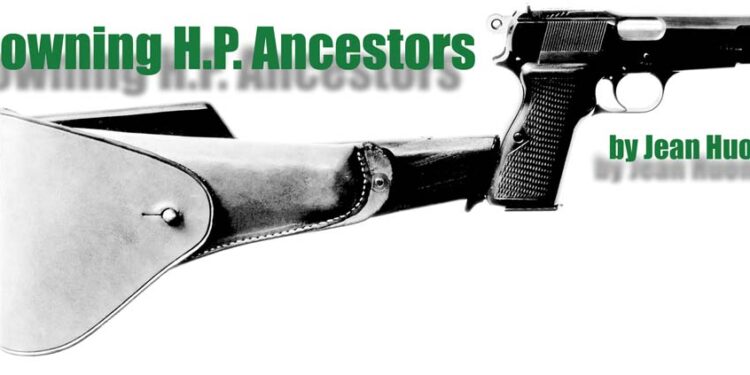BROWING H.P. ANCESTORS
by SAR Staff
in V13N5 (Feb 2010), Articles, Articles by Issue, Guns & Parts, Search by Issue, Volume 13
Share on FacebookShare on Twitter
By Jean Huon
John Browning was undoubtedly the most prolific firearms inventor of the 19th and 20th centuries. He developed a number of pistols patented from 1895 that use various mechanisms such as blow back, gas piston, barrel locked with links and rotary movement.
His inventions were realized by the production of several models on both sides of the Atlantic that included the Browning 1900, 1903, 1906 and 1910 in Belgium made by Fabrique Nationale d’Armes de Guerre de Herstal and, of course, the Colt 1900, 1903 and 1911 in the United States.
In 1911, Fabrique Nationale planed to build the Colt gun, but World War I and the resulting occupation of the Herstal factory when the Germans overran Belgium caused the project to be shelved. After the war, the Belgians returned to the project and developed the Grand Browning pistol in 9.65mm that was derived from the 9.8mm Colt developed in 1910.
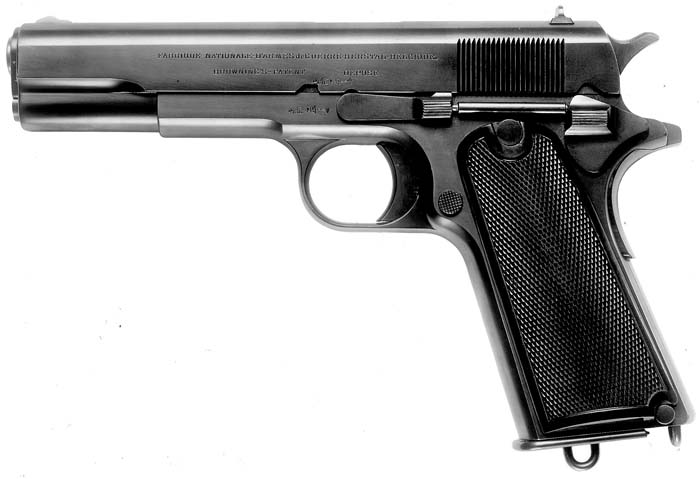
The Grand Browning, caliber 9.65mm, a copy of the Colt M1911.
The French Program
In 1921, the French Army launched a large program of replacement of its small arms with the schedule concerning hand guns drawn up on May 9, 1921. It provided that the future weapon will have to have a caliber close to 9mm firing a 125gr bullet with a muzzle velocity higher than 1,184 fps. The resulting kinetic energy will be about 272 foot/pounds. The rear sight was to be graduated up to 600 meters (660 yards) with a barrel length of 20 cm (7.97 inches). The magazine was to contain at least 15 cartridges and a removable shoulder stock was desired. The weight of the weapon was to be under one kilogram (2.2 lbs) and would have to be simple and easy to maintain. A loading indicator and a cartridge counter were also required.
Informed of this program, the F.N. factory was interested and asked engineer Dieudonné Saive to develop a new gun. He produced a Browning 1903 with a high capacity magazine receiving the cartridges on two columns. The feeding system was solved, but the weapon fired a cartridge whose characteristics were under the requirement of the French. The use of the 9mm Luger cartridge was necessary, but as the 9mm Browning Long Pistol worked perfectly with a blow back device, the 9mm Luger did not.
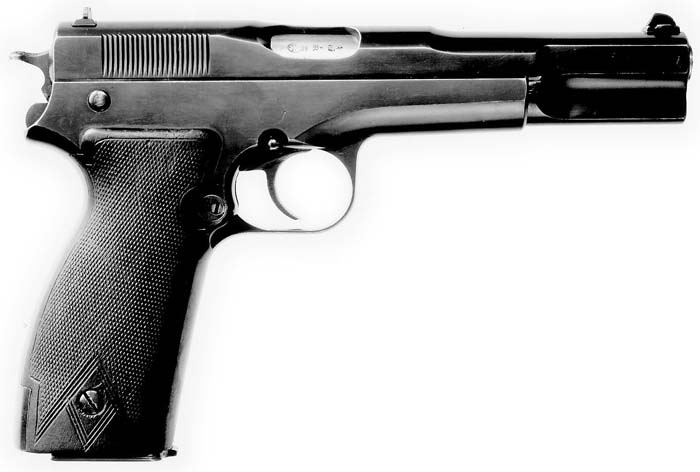
Browning 1925 pistol.
The 15-shot pistol was sent to John Browning with the requirement of the French. He worked on the question with his brother Ed and a few weeks later two prototypes were made. The first had a straight movement barrel and the other had a pivoting barrel with an oblique slope ensuring displacement during locking and unlocking. The two guns were presented to Colt who had the manufacturing rights for Browning’s inventions in America. Colt did pay the expenses of the patent, but declined the marketing of these models. The Browning brothers again turned to the F.N. who chose to develop the model provided with a locking slope.
The American patent of the Grand Rendement pistol was filed on June 28, 1923 and was granted on February 22, 1927 under No. 1,618,510. In Belgium, it is covered by the patent Nos. 304,814 of July 29, 1922; 316,874 of March 24, 1924 and 316,876 of March 27, 1924.
Browning 1922
Two prototypes were made and presented in France in 1922 per Val Browning, son of John, and by Captain Chevalier, an officer retired from the Belgian Army. The two guns vary by the length of their barrel: 121 mm (4.76 inches) and 200 mm (7.87 inches). Both had a rear sight adjustable up to 500 meters and the model with long barrel accommodated a shoulder stock. The safety lever is located at the back of the slide. There is no grip safety or device prohibiting firing when the magazine is removed. The slide remains open after firing the last cartridge.
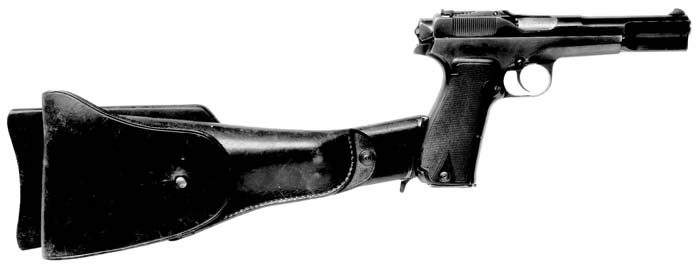
Browning 1922 pistol with stock.
Tests of the Grand Rendement Browning guns were carried out jointly with that of the Grand Browning, which F.N decided to continue production. An internal note of January 22, 1921 established the manufacture of twelve guns and 100,000 9.65mm cartridges.
The French technical testing group chaired by General Emery was more interested in the Browning 1922 pistols than the 9.65mm Browning. The group examined both weapons compared to the characteristics of the May 9, 1921 program and modified on July 25, 1922. It notes with satisfaction that the 9mm cartridge manufactured by F.N gave better results than the 9mm German ammunition fired in the Luger pistol. Initial velocities were respectively 355 m/s (1,167 fps) and 370 m/s 1,217 fps). The weapons had good hand holding characteristics and were suitably balanced and accurate. The weight was slightly heaver than the requirement, but a lightening of at least 80 grams (2.82 oz.) seems to have occurred. French officers desired that the safety be placed on the frame instead of being located at the back of the slide. One officer also noted the absence of an indicator if the striker is in the armed position and no cartridge counter. The summary of the tests showed that generally the operation of these guns and their magazines was satisfactory.
Initial disassembly, although very simple, required the complete removal of a great number of parts that then resulted in a complex disassembly that requires the intervention of a “skillful and vigorous man” for the reinstallation of the recoil spring.
The testing group wished to see several improvements to be brought to the 9mm Browning guns and this decision stops the development of the 9.65mm Browning.
In 1922-23, the French did test various other pistols: 7.65mm Browning 1910; 7.65mm and 9mm Browning 1910/22; Browning 1903: Colt M1911: P 08 and Long P 08 Luger; Steyr 1912; Mauser 1912; Webley & Scott; Lewis; Beretta 1915; Ruby; Lambrecht and Rochet.
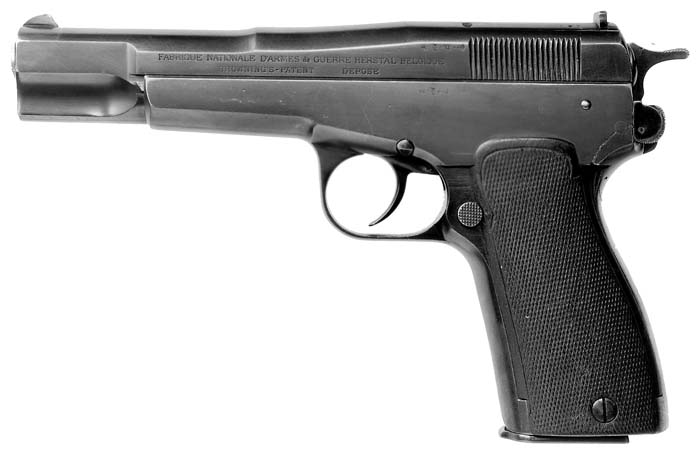
Browning 1926 pistol.
Browning 1923
Following the recommendation of the testing group of the French Army, F.N. improved the Browning 1922, which Mr. Chevalier presented the prototype on March 23, 1925.
Its general organization is the same as that of the Model 1922 but had several essential differences. The internal striker is replaced by an external hammer and the weapon has an absolute safety by a nut on the hammer and an automatic safety when the magazine is removed. The magazine capacity is brought back from fifteen to thirteen rounds.
Disassembly is facilitated by the fact that the slide is maintained in the rear position by the safety. The reassembly of the recoil spring rod is simplified by the presence on one end of a half-moon encasing itself in a corresponding housing of the slide. For this model, F.N. had also carried out an adaptable metal stock, being able to be dismounted.
The Browning 1923 pistol complied with the July 25, 1922 program, except with for the weight, the indication of a cartridge in the barrel and the cartridge counter.
The Versailles Commission of Experiment estimated that this gun was powerful, well in hand, very accurate, with a correct operation, was easy to disassemble without tools and provided absolute safety when disarmed. This enthusiastic appreciation would have involved the immediate adoption of this model, but nothing came of it.
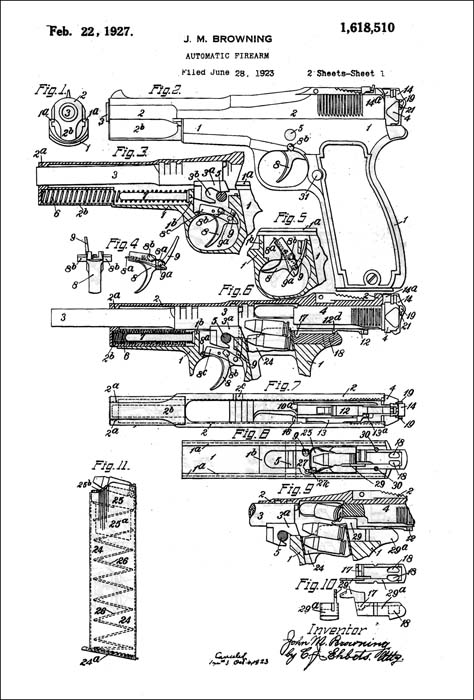
Patent relating to the Browning 1927 pistol.
The Browning 1925, 1927, 1928, 1930 and 1931
Parallel to the tests of the Browning 1923, other studies were undertaken with various foreign pistols existing on the market and also several 9mm pistols developed by French factories.
Army Headquarters modified the specifications of the future weapon on June 2, 1927 and specified that the future gun will use the 7.65mm long cartridge, which is none other than the .30 Long Pedersen.
F.N. continued the development of the Browning gun. The Model 1925 is organized like the prototype of 1923, but the adjustable rear sight disappears and replaced with a fixed U notch. The hammer spur is also less prominent.
After the sudden death of John Browning on November 26, 1926, Dieudonné Saive continued the development of the high capacity Browning gun. On the 1926 prototype, the old large spur hammer came back, the frame was larger and the barrel is shorter.
With the 1927 prototype model, the frame is thinner and the hammer is smaller.
The silhouette of the weapon then changes – the handle is redrawn; the hammer with spur is replaced by a hammer with a drilled peak. The optional safety now is located at the rear of the frame on the left side and the bolt stop is now an external lever placed in front of safety. This prototype was presented in 1928.
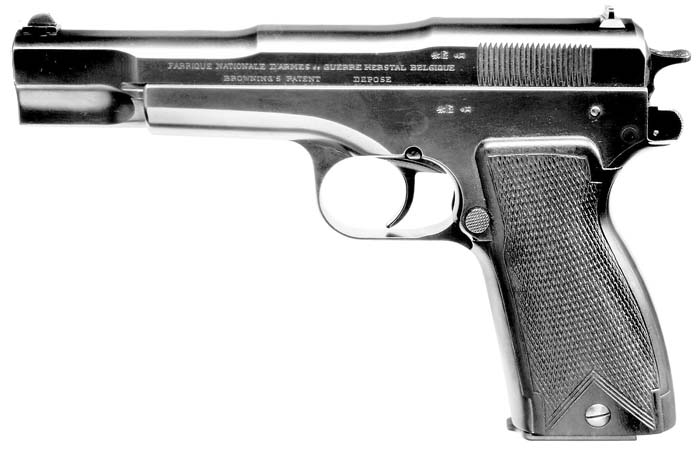
Browning 1927 pistol.
The following year in 1929, a new model with curved back grip is made. It is now close to its final version.
New improvements were introduced on the models carried out in 1930 and 1931. Particularly with more enveloping plates to the back that improves the hand hold and makes shooting more comfortable. The weapon is also proposed with a thin wooden stock with an attached leather holster. In this model the fixed U notch is replaced by an adjustable rear sight.
Pistol Competition
To evaluate on a large scale qualities of the weapons existing on the market, the Ministry of War organized a competition in 1933. The guns were separated in two groups: those chambered in 7.65mm long cartridge (14 guns) and other models (5 guns). But this competition is only a lure intended to test the best existing technical weapons, which will allow French manufactures and companies to develop a national weapon.
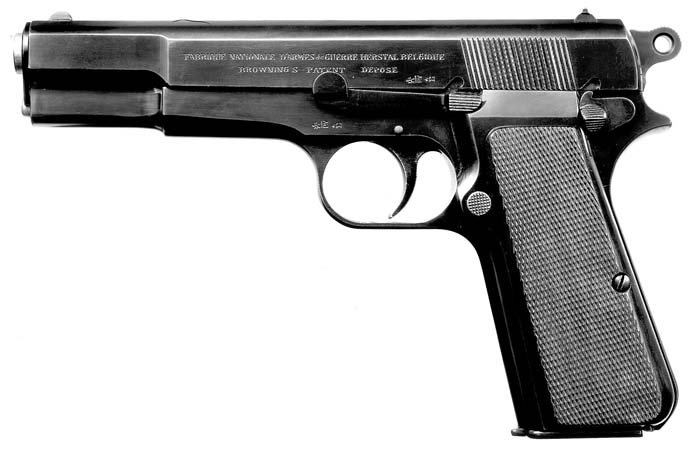
Browning 1928 pistol.
Browning No. 1 Pistol
The Browning No. 1 Pistol is a 7.65mm long blow back pistol. It is provided with a removable lockwork package and a single column magazine. The frame receives the barrel, the slide; the lockwork mechanism and the magazine.
The barrel does not move during shooting. The recoil spring is placed under the barrel and the slide entirely wraps the barrel. The sights are made of a fixed U notch and a half moon front sight. The grip can receive a removable stock. The pistol weighed 855 g (1.88 pounds) without the magazine; the length was 192 mm (7.55 inches) and had a 112 mm (4.40 inch) barrel. This model was appreciated for its simplicity and its removable lock works and ease of disassembly and reassembly. The weapon underwent successful tests for operation and it appears among the models having collected the best results.
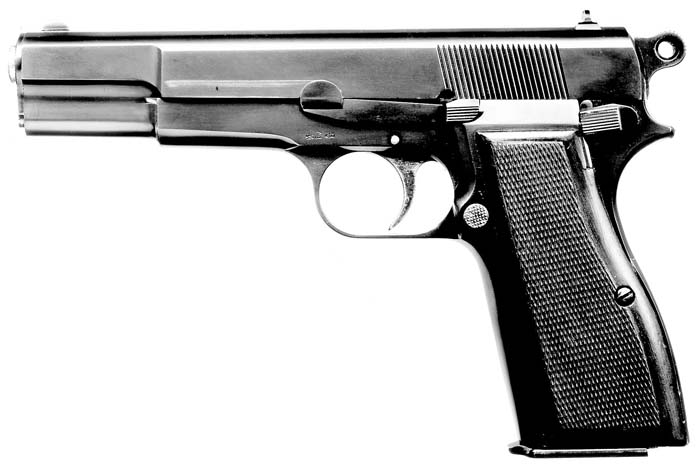
Browning 1929 pistol.
Browning 1930 Pistol
The Browning pistol of 1930 is a 9mm pistol and carries the designation of No. 205. Although far away from the French military program, this gun was appreciated for its simple organization and its reliability. Summary disassembling is very easy, which is not the case of the reassembly that is considered to be long and delicate.
The Browning 1930 precedes the gun that will become the H.P. Browning pistol.
New French Tests
After a new series of tests in 1935, only four pistols were retained: the MAS, the SACM (Petter system), the Belgian F.N. Browning and the Spanish Star. The tests continue until 1937 and France finally adopts an automatic pistol, and to fill its delay, it adopts two of them: The MAS and the SACM models. The pistols presented by F.N. Herstal and Star were discarded.
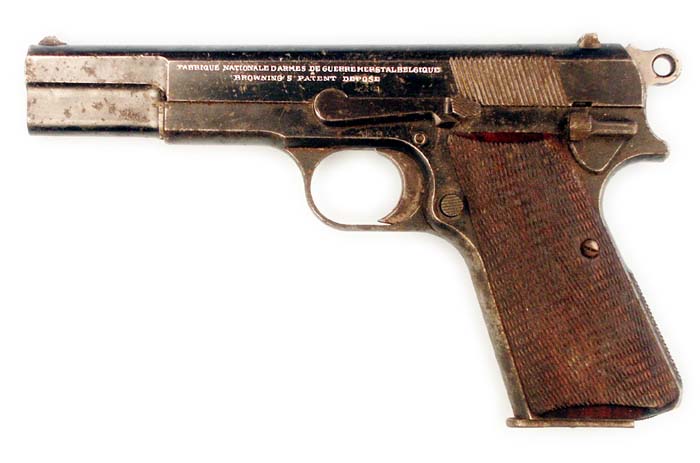
7.65 mm Long Browning 1936 pistol.
Browning 1936 Pistol
The Browning Pistol Model 1936 (firing the 7.65mm long cartridge), is an evolution of the same calibre weapon presented in 1933. The removable lockwork was kept, but the gun works with a locked breach and a short recoil barrel with the same device of the H.P. Browning pistol. The grip of the Browning M1936 is particular. Its trapezoidal shape looks like the Vis 35, which is not that odd since Belgian technicians at F.N. had collaborated in the development of the Polish gun.
The Browning Model 1936 was the subject of a patent proposed in France on March 4, 1935, and granted on June 17 of the same year under No. 786,652. A similar request had been proposed in Belgium on March 1, 1935.
The left side of the slide of the Browning in 7.65mm long has the same inscriptions as on its counterpart in 9mm: Fabrique Nationale D’Armes de Guerre Herstal Belgique Browning Patent’s Depose. On the right face of the gun intended for the tests of the French Army: Manufacture D’ Armes De Paris.
This establishment (MAP), founded in 1915 in Saint-Denis in the northern suburbs of Paris by two Directors of F.N. and French industrialists, manufactured armament during World War I. Thereafter, MAP made precision machine parts. In 1921, F.N. takes a majority share in the capital of MAP and the company is then occupied by manufacturing typewriters. This activity does not give good performance and it decided to devote production to tools that F.N. needs to satisfy important military orders (China, Poland and Belgium). MAP also seems to have played the part of distributor for certain F.N. products in France, which would explain the affixing of its company name on the Browning Model 1936. The control of MAP by F.N. ceased in 1937. The company was then repurchased by the Hotchkiss company.
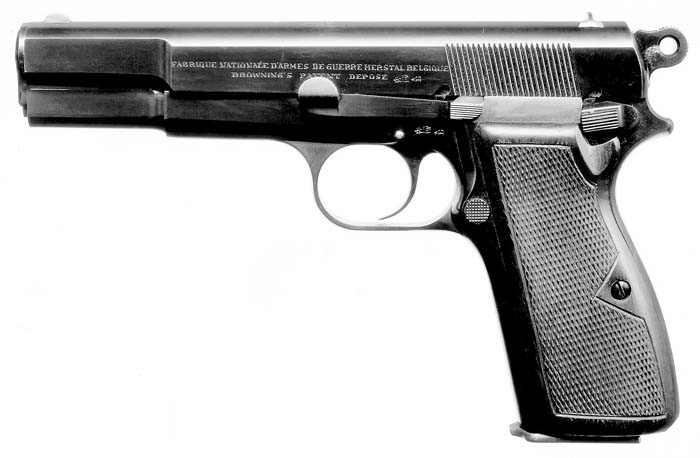
Browning 1930 pistol.
The general organization of the weapon reveals a frame that supports the barrel and the slide; it contains the removable trigger mechanism and the magazine. The recoil spring is placed under the barrel and the sights are a rear open U notch and a front half moon;
This pistol could be provided with a tangential rear sight allowing shooting up to 500 meters. In this case, the option was available on the back of the grip for the attachment of a wooden stock.
The safety is placed at the left rear of the frame. The bolt open lever is on the same side, just above the trigger. The single column magazine is placed in the grip. The left face of the magazine has holes in it to be able to check its contents. The magazine is locked in the pistol by a transversal push button located just behind the trigger guard on the grip frame. The weapon is provided with a magazine safety that allows the slide to remain open on the last shot fired.
The design of the Browning 1936 pistol is different from that of the H.P. 35, particularly with regard to the trigger mechanism. The Browning 1936 works with a short recoil barrel. The H.P. 35 has a fixed barrel assembled like the m1903, 1910 and 1910/11 pistols. Except for this mounting, the other characteristics of the weapon remain unchanged. For disassembly, the barrel has to be removed as on the M1910 or similar guns.
Except for the location of the safety, the Browning Model 1936 fully answered the French program fixed at the conclusion of the competition of 1933, but the weapon was not retained. The elimination of the Browning gun results are probably more political and economic considerations.
The technicians at F.N. were quite bitter because of this and the files of the company still have the provisional technical notes on which the following handwritten note mentions: “GP studied for the French who did not adopt it but did made a copy.” This is not completely exact, because only few points are common with the F.N. pistol and MAS or SACM pistols.
The program of the French Army was responsible for the research conducted by F.N. in the hopes of it being adopted by the French. The anxiety expressed by the Belgians at the time by being shut out is understandable, but as it turned out it they created one of the best guns existing in the world.
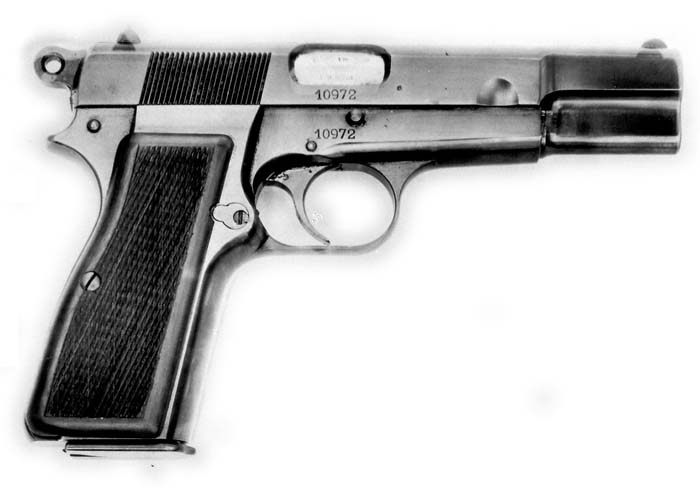
G.P. 35 pistol No. 10962 tested in France in March 1940.
The Browning Model 1935 G.P. was a huge success for F.N. and they produced more than 1.5 million guns and were brought into service by more than one hundred countries.
In a bit of irony of history, the French, whose manufacturers were not able to build a sufficient number of guns before the declaration of war, asked F.N. to provide them with the Model 1935 pistols. Two examples, numbered 10,933 and 10,972 were delivered in March and April 1940, where they gave excellent results. But it was too late. In May 1940, Belgium and France were invaded and the project could not be concluded.
